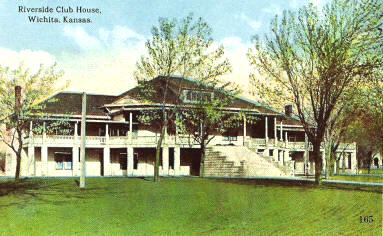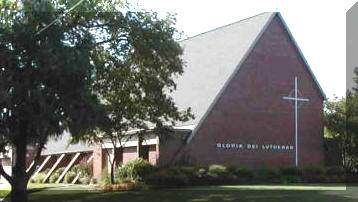|
Then and Now: Riverside Club
Conversations during a Whist game, which led the city’s elite to envision a club for swimming, boating and tennis, resulted in the grand opening of the Riverside Club 15 months later, on Feb. 25, 1910.
"The Riverside club was organized and financed in three days’ time and $10,000 pledged to guarantee success of the enterprise," said the Wichita Beacon’s Dec. 11, 1908 article.
The club had been incorporated in December 1908; a contract let for construction of the club building Jan. 25, 1909, and construction started July 1, 1909 at the corner of River Boulevard and Briggs.
 |
Postcard view of the Riverside Club at the
intersection of Briggs and North River Boulevard. Its grand opening was Feb.
24, 1910.
(Photo credit: Peerless Princess of the Plains, Postcard Views of Early Wichita, Two Rivers Publishing Co., 1978) |
P
orter street, one block west of River Boulevard, was closed at its north end, and the grand clubhouse was built facing south, rather than toward the river, so that visitors could ride the recently expanded trolley line north on Porter to the very entrance of the building.Tennis courts were constructed north of the building and the Little Arkansas River dredged for 300 feet to create a bathing beach for members.
There were even plans for a boathouse at the north end of the beach "with a capacity of 40 to 50 canoes…plus dressing rooms for bathers, springing boards and floating platforms," reported a June 9, 1909 Wichita Eagle article.
The article also said, "The city will dredge a channel on the west bank of the river… The sand pumped will be used to construct a beach." However a July 12, 1911 article reported the city had just purchased "the sand boat that was built and used by the Riverside Club to make a swimming area in the Little River at the club grounds," so the club might have had to bear expenses they had not planned for.
The boathouse cost was estimated at $1,100, but that was not the end of their expenses. The Riverside Club also paid to build a 40 foot long pontoon bridge over the river "so that women, children and poor swimmers" could reach the shallow water opposite the diving boards on the west side said a June 7, 1912 article.
Such expenses lead to financial trouble. The original estimated cost of $15,000 for the clubhouse had turned out to be $30,000.
Although the club’s directors attempted to increase their exclusive membership limit from 250 to 400, the number peaked at 350 in March 1915 and, by Jan. 4, 1917, the number had dropped to 200. Income from memberships were decreasing, and back taxes were mounting.
Facing a bonded indebtedness of $18,000 plus other debts, the Riverside Club closed its doors Jan. 3, 1917.
Club president Walter Henrion predicted the club would be reorganized and reopened for the spring and summer seasons, however that was not to be. The club organized by Ex-Governor Stanley eight years earlier had died.
One year later the property, valued at $20,000, was purchased by the Midian Temple for $12,500 and, for six years, Shriners enjoyed the clubhouse and its nearby beach.
But The Midian Shrine was expanding and, upon completion of their downtown club building at 115-117 North Topeka, they sold the Riverside tract and clubhouse to the Board of Education for $35,000.
A March 10, 1927 Wichita Beacon article said the $11,000 an acre the BOE paid for the property was too much, adding that the clubhouse had "deteriorated and was sold for less than $1,000 by the Board of Education after it acquired the property."
Little is mentioned about the building or the land for the next 20 years, but ground was broken for a new church edifice of the Gloria Dei Lutheran congregation on the site, Sunday, March 16, 1947.
| The Gloria Dei Lutheran Church now
occupies the Riverside Club site. (Photo credit: D & V Churchman) |
 |